There are people who only see Gaza in terms of numbers, looking at a screen of digits to keep the human suffering of the people of the strip out of sight.
These are the characters who consider this place, home to 2.3mn people, to be a “chronic disease with no remedy other than a “nuclear bomb”.
That was the suggestion of the Israeli Minister of "Heritage," Amihai Ben-Eliyahu.
His words will remain infamous even among the literature of nuclear diplomacy and provocative dialogue in the Middle East for years to come.
Ben-Eliyahu expressed clearly what the Israelis and their allies in the West want. And he did so by imagining the annihilation of the population of Gaza – and labelling it as inevitable – for reasons relating to the economy, oil, and politics.
These considerations are already pretexts for an attack against what should be a more precious consideration: the people of Gaza. Nuclear weapons may not have been used – but to the thousands of defenceless people already dead, including so many children including so many children, and their families – it already feels like genocide.
And the tally of dead children is still rising, as it has been – mercilessly – ever since Israel’s bombing campaign began. Even for those who only see Gaza in numbers, the following statistics are surely shocking. They have stoked deep concern around the world:




